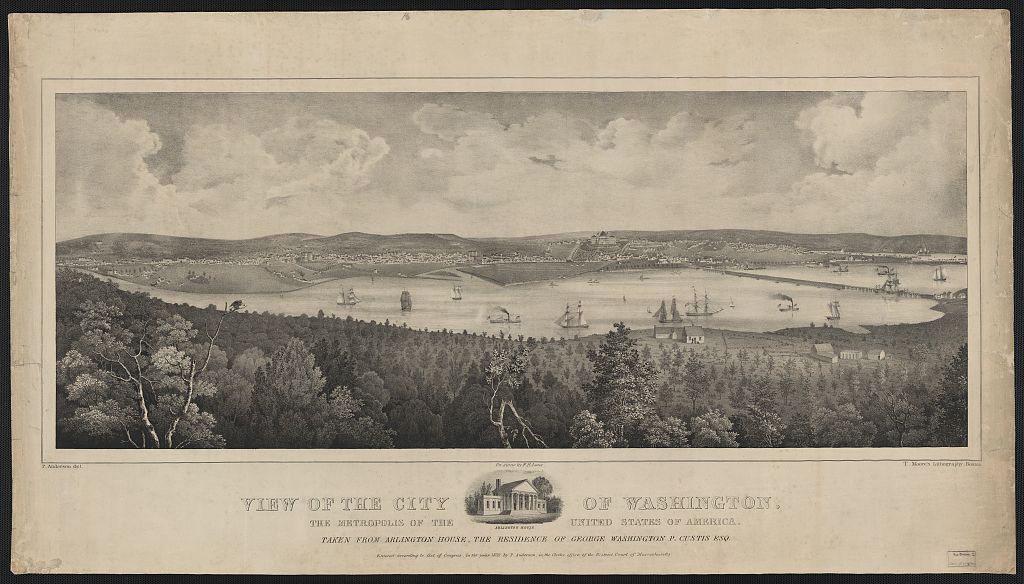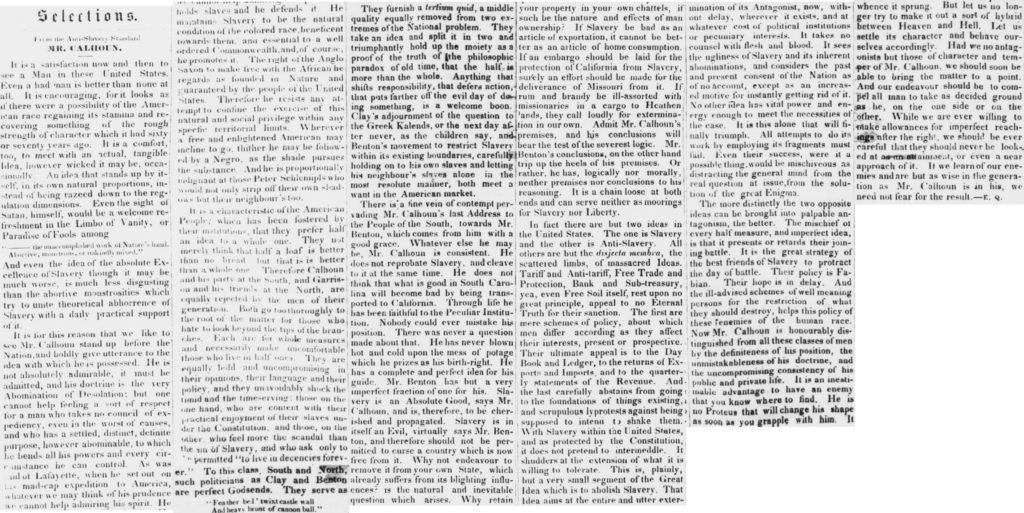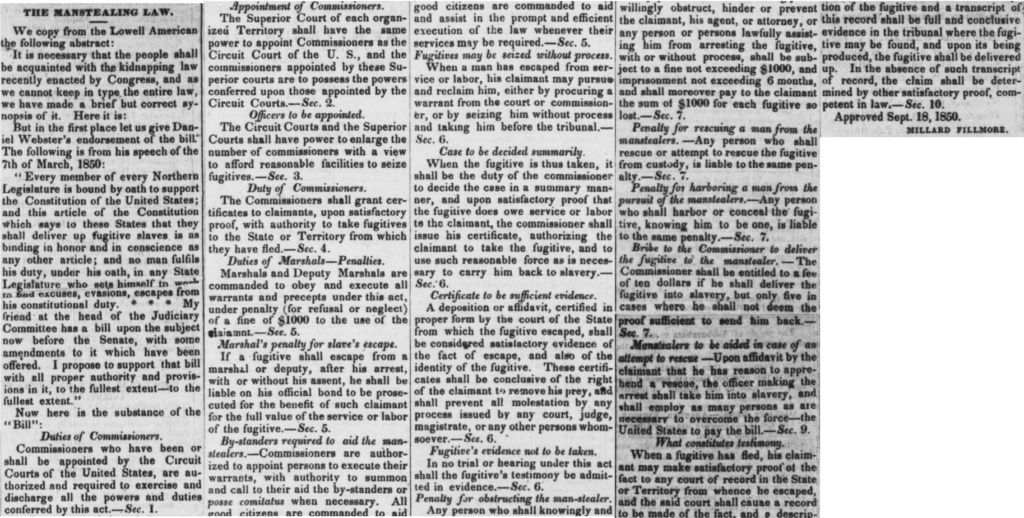
As an abolitionist newspaper, The North Star was deeply concerned with the religious and moral evils of slavery. It spoke repeatedly on the hypocrisy of Christians claiming to own other people, and often used this language to criticize the broader public morality that allowed this system to exist. While the paper focused on the evils of slavery in several different respects, it consistently discussed enslavement as a political issue. The political power of enslavers, through their control of the US Congress, was an especially significant focus. The number of Senators from states that continued to allow slavery in the US Congress enabled the South to continue abetting the expansion of slavery in newly obtained territories. The North Star saw this as the result of the weakness of Senators that refused to act in a way that prioritized freedom, even if they claimed to be opposed to slavery. While the paper clearly criticized southern Senators for their impassioned support of slavery, The North Star also criticized northern Senators who consistently failed to resist the demands of the “Slave Power”.
Topics and First Articles
These critical representations of the US government and its officials are clearly visible in the topic models, which highlight articles that critiqued elected officials and expressed alarm over the Fugitive Slave Act. Some articles went beyond criticism, and contrasted the actions of the Senate against the Northwest Ordinance that prohibited the expansion into Michigan and other recently added Midwestern states. Mouse over individual points on the chart to what percentage of that topic made up an issue of The North Star, and see when that issue was published:
| Webster and Betrayal of Anti-Slavery | webster jury daniel speech thi louis tht sire snd emperor ere thst seward ordered henriette tie aud napoleon trial horse |
| Criticism of Individuals | clay kentucky goldsmith clays feb elder robert carlyle march gradual bred foote peter oliver duration bondage vanity races fist burke |
| U.S. Senate | vote nays yeas bill motion house voted king jan amendment association proposition feb ordered christianity resolution ounce resolutions cents conference |
| Senators | senator district bill mob hampshire foote property hale abolition mississippi violence columbia subject snd attempt jackson calhoun honorable meet senate |
| Fugitive Slave Act | law fugitive slave bill united person states court constitution judge fugitives case state claimant act city trial service arrested corpus |
| Prohibition of Slavery | ordinance territories jackson milton randolph luck coon pounds song soe mure acceptance sayd pinney dayton bonaparte demo entertain tons waiter |
| Imprisonment of William Chaplin and Other Information | chaplin james smith london book cook brougham jackson defendant duke harvey myers william wit require violet gerrit cazenovia oconnell samuel |
Many of these topics related directly to articles that discussed U.S. Senators and the positions that they had taken in relation to slavery. The debates of the Senate were a key focus of the paper, and individual Senators of note were mentioned repeatedly during the paper’s run. Even outside of the goings-on of the Senate, Senators and their records were discussed in great detail. Being included outside of debates and speeches was rarely positive however, as these publications often amounted to direct and sustained criticism of the senator and their point of view.1 Many examples emphasized negative beliefs or coverage about Senators like John C. Calhoun, Henry Clay, or Daniel Webster. Their names are all visible in the list of key words associated with each of these topics.
The other topics relate to specific bill that were passed by Congress. They include the Fugitive Slave act and the prohibition of slavery in some states through the Northwest Ordinance. The Fugitive Slave Act came to be as part of a compromise between the North and South. The bills that solidified that compromise were called the Compromise of 1850, which would create new states in both the North and South as well as pair the abolition of slavery in Washington D.C. with the passage of the Fugitive Slave Act. The Fugitive Slave Law of 1850 allowed for the capture and return of escaped enslaved people to their enslavers without any due process. As a result, Black Americans who had been emancipated or were never enslaved in the first place could be enslaved. The bill was, for many abolitionists, the most hated element of the Compromise of 1850. Until all of the bills were passed, speeches and articles that critiqued and discussed the bill were frequently part of the paper. Upwards of 20% of later issues of the paper were invested in discussing this topic, or reprinting the arguments in Congress regarding its passage.
These first articles in The North Star allow us to build off of the information that is visible from the topic models. Because this section of the paper was most likely to include excerpts from speeches or proceedings in the Capital, several articles focused on politics in DC and debates surrounding the continued legality of slavery in the Capital. In fact, Washington, D.C. was the the most frequent location amongst first articles. Within the types of reporting that occurred, such as articles, letters, or direct text from laws, there was a clear focus on speeches and sermons. In the context of Washington D.C. this predominantly meant direct pieces from arguments or speeches heard in the US Senate. Perhaps the focus on the seat of government is unsurprising, but it does point to how interconnected activists saw slavery and American politics.
We know what kind of articles appeared at the beginning of the paper, and we know broadly what the paper talked about. Is there anything that this more focused analysis can reveal? First articles voiced critiques of individual bills or policies, but also emphasized deeper conversations that related to the founding principles of the United States. Many articles highlighted the U.S. Constitution and the Declaration of Independence, and used them to argue that promises of freedom had gone unfulfilled for people of color. Overall, first articles that appeared in The North Star treated the Declaration of Independence more favorably. Articles and excerpts often repeated the Declaration’s call for freedom, and criticized the U.S. Constitution for being a compromise that allowed for slavery to grow and fester.

Reverend Theodore Parker, an abolitionist in Boston, highlighted an abolitionist perspective on the Declaration of Independence and the US Constitution in his eulogy for President John Quincy Adams. These views weren’t held universally however. Some saw them both as morally flawed documents, while others saw them both as documents that pointed to higher moral cause that the country ignored to the benefit of slavery and enslavers.
Thinking specifically about the words that Reverend Parker used, what judgements do you see being made? How is the author articulating the difference between the Constitution and the Declaration of Independence? What does the focus on politics and the US government say about the priorities of The North Star?
Below are two example articles that relate to several of the topics that were apparent in the analysis above. Both include context about the article and it subject matter, and end with questions that ask you to relate the subject matter to the broader theme.
Example Articles
Critiquing Senators
On August 17, 1849 the paper published a piece from The Anti-Slavery Standard talking about John C. Calhoun, the noted advocate of slavery and Senator from South Carolina. The piece, visible below, discussed the commitment of Sen. Calhoun to enslavement and compared him to other supporters of slavery. What the piece found horrifyingly admirable about Calhoun was his staunch commitment to slavery, “one cannot help feeling a sort of respect for a man who takes no council of expediency, even in the worst of causes,” Obviously, this is not meant to be positive but it does highlight The North Star’s critique of the half measures pursued by the Senate. The newspaper argued that these half measures only sustained the enslavement of Black Americans, and were thus little better than the full hearted defenses of slavery mounted by Calhoun. The article argued:
They furnish a tertium quid, a middle quality equally removed from two extremes of the National problem. They take an idea and split in two and triumphantly hold up the moiety as a proof of the truth of the philosophic paradox of old time, that the half is more than the whole. Anything that shifts responsibility, that defers action, that puts further off the evil day of doing something.
“Mr. Calhoun” From The Anti-Slavery Standard in The North Star, August 17,1849, p.1.
https://www.loc.gov/resource/sn84026365/1849-08-17/ed-1/?sp=1

https://www.loc.gov/resource/sn84026365/1849-08-17/ed-1/?sp=1
Have other examples from this text on this page or any other highlighted similar beliefs to those that the author attributes to Senator Calhoun? Another worthwhile question draws on modern-day discussions of whose stories are told or emphasized in public history. Why are specific Senators discussed in The North Star more likely to be remembered today than some others? John C. Calhoun and Henry Clay are more well known, even if there were other people (like John Quincy Adams or plenty of unnamed men and women) who fought to resist or abolish slavery in the United States. Who should we remember or celebrate today?
“The Compromise Bill” and the Fugitive Slave Act
1850 was a period of major focus on political discussions for The North Star and other abolitionist newspapers. Long speeches could cover the entire front page of the paper, with additional analysis of the speech and its merits in the second page and beyond. Outside of speeches from politicians, abolitionist organizations also got involved. They passed resolutions that highlighted the act and called out those responsible for supporting it. The October 24, 1850 edition of the paper published an article from the Lowell American that highlighted the evils of the law. It also specifically criticized Senator Daniel Webster for his support of the law.

Conclusion
As the capital of the United States, D.C. would have been a major focus of the abolitionist movement. Similar to the Civil Rights movement and women’s suffrage movement that each came after it, abolitionists sought to use the political status of the city to draw attention to their cause. For abolitionists, the nation’s capital sat at the heart of the successes and failures of the United States. They emphasized that the capital itself remained a site of enslavement and participant in the slave trade. At the same time, parts of the abolitionist movement also drew inspiration from the Declaration of Independence and other founding documents. This conflict between what the nation’s capital was meant to represent, and what it actually meant for people of color in the United States served as a powerful symbol for what the abolitionist movement sought to change about their country. The North Star centered discussions of slavery in its understanding of politics at the national level, and emphasized how slavery corrupted the ideals the country had been founded on.
The North Star saw the key role Senators could play in maintaining or abolishing slavery, and emphasized to its readers the ways that many failed to fight for abolition (let alone equal rights). Even as the paper criticized men like Sen. Calhoun who were avid supporters of slavery, it also critiqued those who accepted a middle-ground between support for slavery and abolition. The “Mr. Calhoun” piece even argues, “In fact, there are but two ideas in the United States. One is slavery. The other is anti-slavery.” This piece highlights how abolitionists saw the struggle against advocates for slavery. Partial solutions were not presented as working to solve the problem, rather they were part of the problem of people failing to prioritize abolition. This prompts a question that relates to the history of the abolitionist movement as well as present day discussions around racial justice: when is compromise important and when is it counterproductive? Are there principles that Senators and other government representatives should be willing to compromise on, and others that they should not be willing to compromise?
- “Henry Clay and African Colonization” From The Liberator in The North Star, February 11, 1848, p. 1.
- “Another Victim of the Slaveholders” The North Star , September 5, 1850, p. 1.